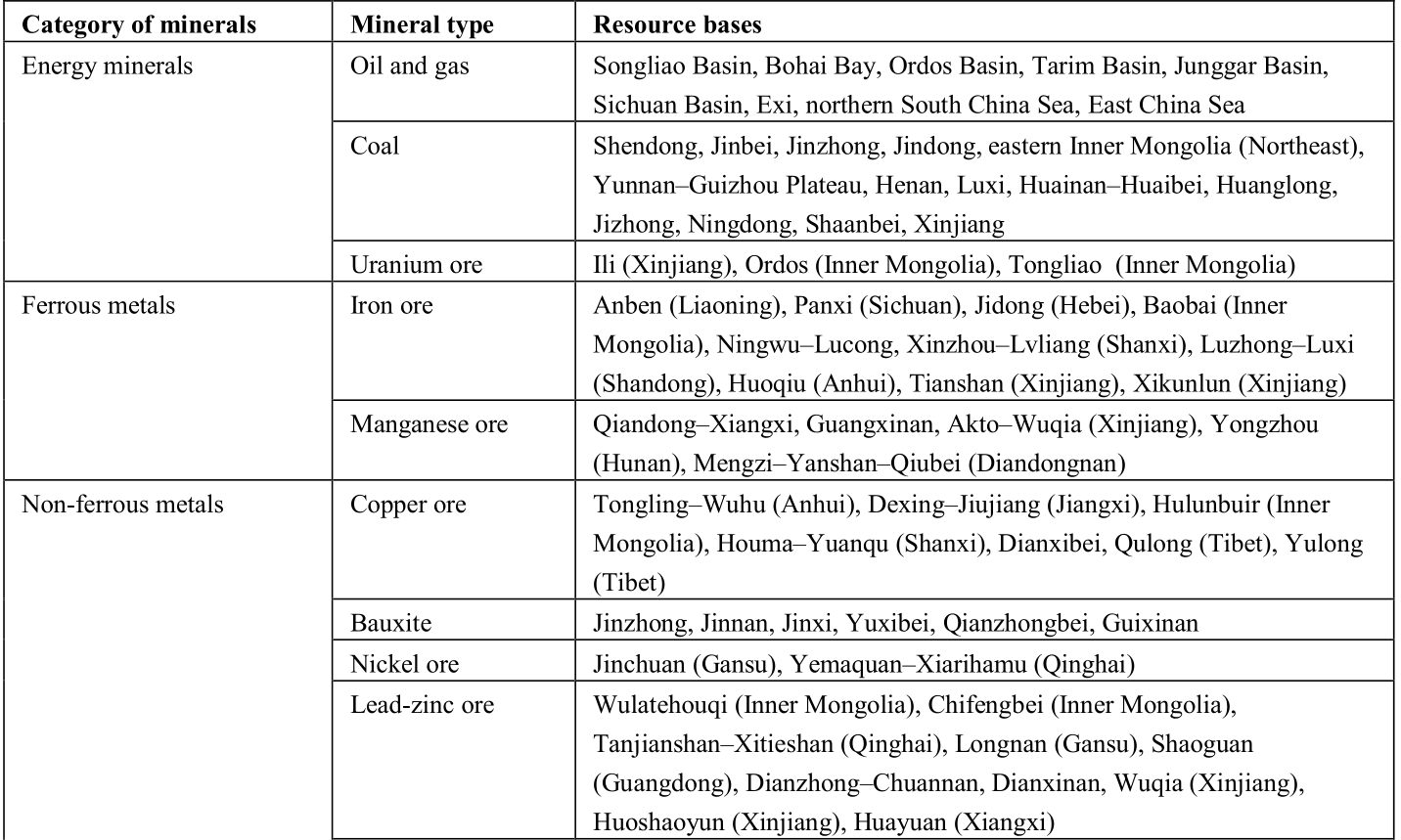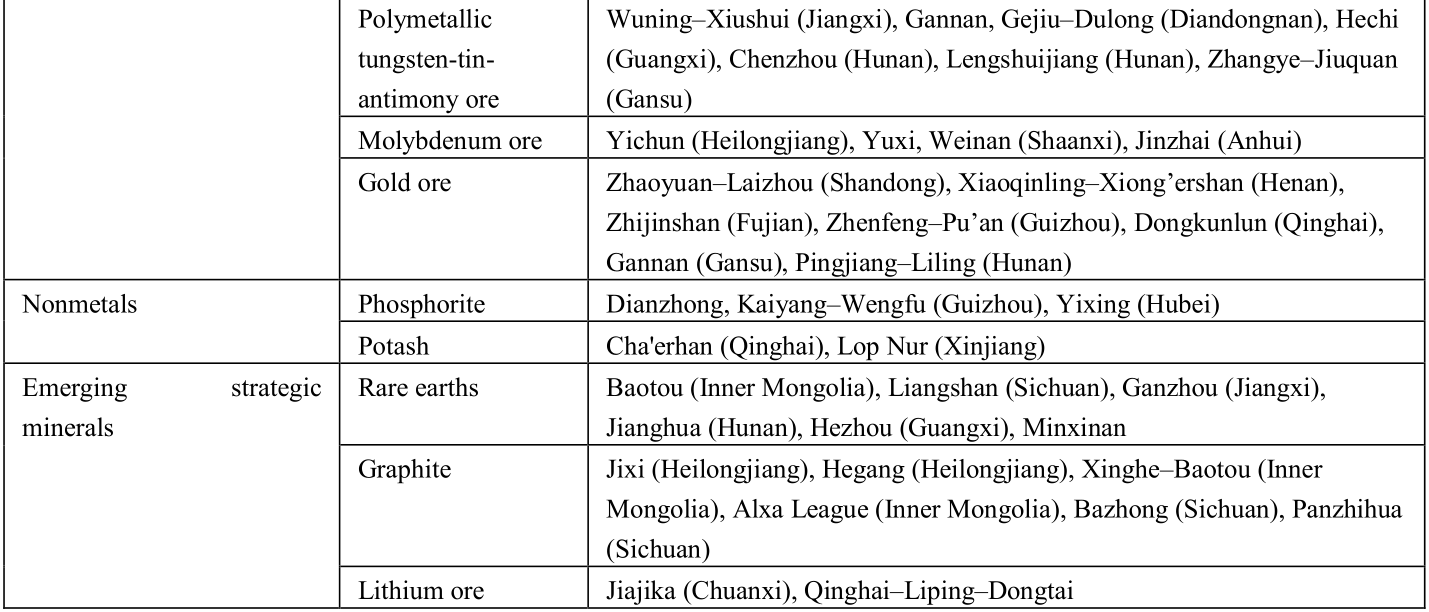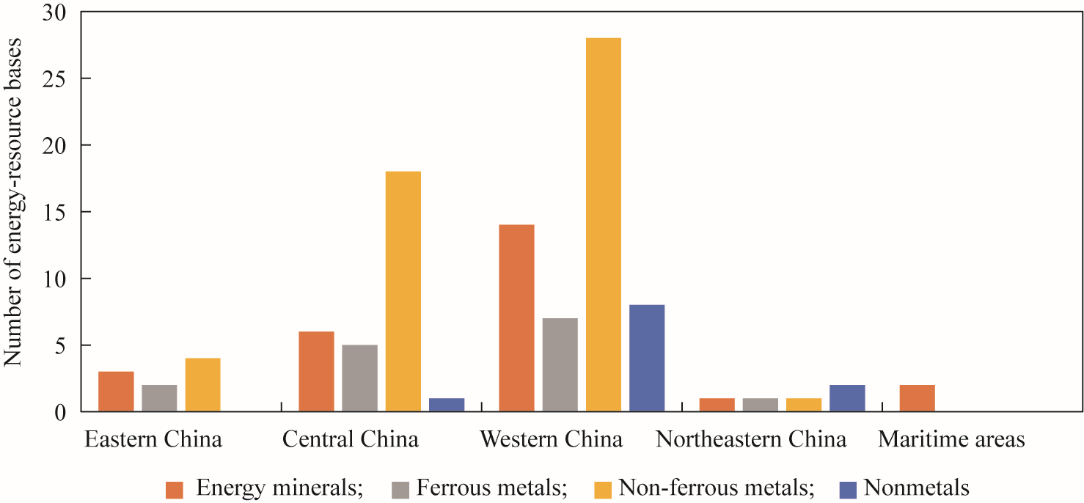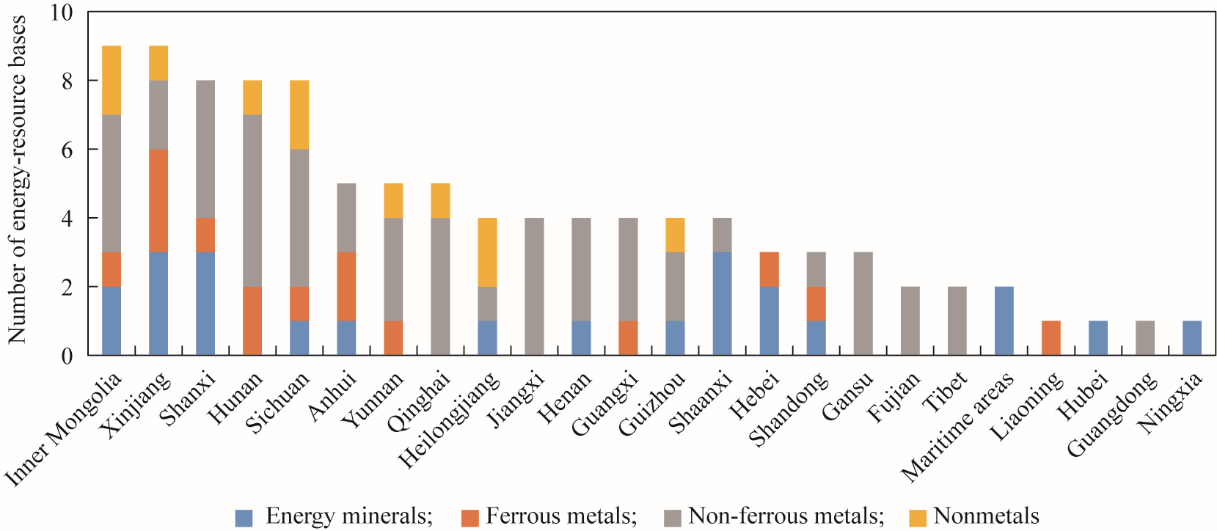《1 Introduction》
1 Introduction
Since the 18th National Congress of the Communist Party of China, Xi Jinping called for a holistic approach to national security, which has guided efforts to maintain the national security of China. Mineral resource security is an important component of holistic national security, as it is an important measure of a country’s ability to manage its security [1]. To safeguard the security of a country or region’s mineral resources, it is necessary to first ensure adequate levels of resource production and resource use efficiency, thus resolving resource supply problems internally [2]. The construction of large-scale energy-resource bases to form mineral supply centers of national importance is an important approach for intensifying and scaling mineral resource developments. These bases will promote efficient mineral resource exploitation and use, enhance the security of mineral resource supplies, and improve the social and ecological security of China, thus increasing China’s overall level of security.
The delineation of key areas for the concentration or prioritization of conservation/development efforts is an important part of how the natural resource and environmental departments of China and other countries conduct their resource development and protection duties. This includes the delineation of key biodiversity areas [3–5], domestic forestry bases [6], large-scale coal bases, and important ecological areas [7–11]. Since mineral resources are an important part of a country’s natural resources, it is necessary to delineate key mineral resource areas (in the spatial sense) to focus development, conservation, and management efforts. Although studies have examined strategic contiguous mineral resource areas, key metallogenic belt, and key mineral exploration areas, there is a scarcity of research about the delineation of energy-resource bases for the security of China’s resource supplies. Furthermore, reports about the basic theories and management policies that underline the delineation of energyresource bases are effectively non-existent.
To fill this gap in the literature, the connotation, theoretical foundations, purpose, and delineation principles of energy-resource bases have been defined in this study according to the grounding theories of energy-resource bases, and the distribution of the 103 energy-resource bases proposed in the National Mineral Resources Planning (2016–2020) document was analyzed. Policies were then recommended for the management of China’s energyresource bases.
《2 The connotation and purpose of energy-resource bases》
2 The connotation and purpose of energy-resource bases
《2.1 The connotation and function of energy-resource bases》
2.1 The connotation and function of energy-resource bases
Energy-resource bases are key strategic areas for national mineral resource security that are generally selected from important metallogenic areas (including important oil and gas-bearing basins) with favorable conditions for metallogenesis, excellent mineral exploration potential, and a relatively concentrated distribution of mineral resources. Energy-resource bases enhance the scale and intensity of mineral resource exploration and development works, and the delineation of an area as an energy-resource base is based on the area’s resource reserves, foundations for development, and ecological environment.
The function of energy-resource bases is to aggregate production factors, promote integrated mineral exploration and exploitation, and enhance the scale, intensity, and standardization of mineral resource exploitation at national macro-scale level. Energy-resource bases will therefore become core strategic areas for ensuring the security of China’s mineral resource supplies.
《2.2 Theories that ground the establishment of energy-resource bases》
2.2 Theories that ground the establishment of energy-resource bases
The importance of constructing energy-resource bases is grounded in resource security theory, industrial agglomeration theory, the theory of economies of scale, resource allocation theory, sustainable development theory, and location theory.
(1) Resource security theory: Resource security is the ability of a country or region to obtain natural resources in a stable, timely, and economical manner, regardless of the generation in question (i.e. the current generation or future generations) [12]. Since mineral reserves are finite by nature, and the rate of mineral exploration and development is limited by technological level and cost, it is inevitable that conflicts will arise between the finite nature of mineral resource supplies and the infinite needs of mankind. If the incongruity between mineral supplies and demands are not predicted and addressed rationally, mineral supply problems will emerge and obstruct the sustainable development of human civilization [13,14].
(2) Industrial agglomeration theory and theory of economies of scale: In addition to ensuring the security of China’s mineral resources, energy-resource bases also play an important role in maximizing industrial agglomeration. Energy-resource bases effectively agglomerate mineral development activities and mining-related enterprises, which dramatically increases the scale and intensity of mining industry development. This promotes industrial agglomeration and ultimately leads to the establishment of an industrial cluster within the energyresource base. The formation of an industrial cluster then leads to external, networking, and innovation benefits and self-reinforcement [15]; this will drive technological innovation and technical diffusion in the mining sector, which continuously enhances the capacity of the industrial cluster to drive its development.
(3) Resource allocation theory: Resource allocation refers to the comparison of different uses to determine the appropriate allocation of scarce resources. The construction of energy-resource bases is an effective means for optimizing the allocation of mineral resources, which consists of temporal and spatial dimensions. In the temporal dimension, energy-resource bases facilitate the orderly extraction of mineral resources by limiting the scale of mineral exploitation according to scientific knowledge. In the spatial dimension, energy-resource bases help to balance and coordinate regional growth by accounting for the actual needs of each region and each stage of economic development.
(4) Sustainable development theory: The mineral development activities of an energy-resource base must maintain the sustainability of regional socioeconomic development. In the production of mineral resources, the “small, multitudinous, scattered, and disorganized” mode of development must be abolished, to eliminate inefficient mineral extraction methods, obsolete extraction technologies, and low multipurpose use rates. It is also important to prohibit unlicensed mineral extraction and extraction beyond permitted boundaries, to stringently enforce the orderly development of mineral resources. Furthermore, disturbances to the ecological environment must be minimized. Energy-resource bases must regulate their activities according to “Green Mine” standards to achieve high-quality development in the mining industry.
(5) Location theory: Location theory is an integral part of spatial economics. In this framework, the location of an entity has two levels of significance. The first aspect is the physical location of the entity, and the second aspect is the spatial relationship between the entity and other economic entities. Although mineral resource developments are based on resource endowments, they are still affected by factors like the availability of water, transportation, and energy. Furthermore, industrial agglomeration tends to exhibit history and path dependence. Therefore, location selection is a necessary step in the delineation of energy-resource bases.
《2.3 The purpose of energy-resource bases》
2.3 The purpose of energy-resource bases
This study proposes that energy-resource bases serve four purposes:
2.3.1 Safeguard the security of national resources and enrich the nation’s reserve of mineral resources
Energy-resource bases are areas in China that contain a concentration of large and medium-sized mineral deposits, and each of these bases contains a considerable proportion of China’s reserve of mineral resources. These bases are therefore an important vehicle for safeguarding the security of China’s national resources, and they are responsible for supplying the raw materials and products necessary for developing China’s economy, military industries, and high-tech industries. Additionally, the establishment of energy-resource bases will expedite the discovery of new resource reserves and thus enrich China’s reserve of mineral resources.
2.3.2 Increase the scale and intensity of mineral resource developments and optimize development structures
The mineral resource developments in China tend to be small in scale and intensity, as China has only a few large and ultra-large mines but a large number of small ones. Therefore, mineral resource developments in China are still dominated by the “small, multitudinous, scattered, and disorganized” mode of development. The construction of energy-resource bases will form areas for the agglomeration of mineral resource developments, which will promote the spatial agglomeration and intensification of mineral development activities. This will help optimize the structure of mineral resource developments in China.
2.3.3 Standardize the order of mineral resource developments and unify the management of the mining sector
In energy-resource bases, state-planned mining areas will be designated as key areas for management and monitoring, to unify the planning of mineral resource developments and increase barriers to entry. This will help eliminate inefficient mineral extraction methods, obsolete extraction technologies, and low multipurpose use rates. Furthermore, the unification of managerial measures will help prevent illegal behaviors such as unlicensed mineral extraction, extraction beyond permitted boundaries, and illegitimate competition for mineral resources. Therefore, energy-resource bases will help maintain order in the development of mineral resources and transform the development of the mining sector.
2.3.4 Use economies of scale to promote the development of regional economies
Energy-resource bases are not merely regions for the agglomeration of mineral development activities, as the formation of an energy-resource base will draw downstream industries towards the base because of the effects of economies of scale. As such, spatial linkages will be established between raw material industries and production industries. The development of other related industries will then be driven by forward, backward, and lateral industrial linkages, thus promoting technological progress and sustainable socioeconomic development throughout the region and ultimately improving the standard of living of the local population.
《2.4 Principles for the delineation of energy-resource bases》
2.4 Principles for the delineation of energy-resource bases
2.4.1 Resource-based delineation
The first and most important consideration in the delineation of energy-resource bases is the local availability of mineral resources. Each region should be assessed according to their concentration of mineral-producing areas so that regions with advantageous resource conditions and a concentrated distribution of medium and large mineral deposits will be prioritized for delineation as energy-resource bases.
2.4.2 Coordinated regional development
Assuming that the prerequisite mineral resource conditions are met, the delineation of energy-resource bases should also serve to coordinate development between eastern, central, western, and northeastern China. In particular, energy-resource bases should be delineated to support the call of the 19th National Congress to accelerate development in old revolutionary bases, ethnic minority areas, border areas, and poor areas, and strengthen the “great western development” program. The construction and deployment of energy-resource bases also has an important role to play in promoting balanced regional development, especially in deepening reforms to accelerate the revitalization of old industrial bases in Northeastern China and the use of central China’s intrinsic strengths to boost its development.
2.4.3 Suitability for development
Energy-resource bases are areas for the spatial agglomeration of mining industries and their related production activities. Therefore, the development of mineral resources and other downstream industries must be conducted on lands with a certain level of ecological bearing capacity, to ensure that the ecological balance of the region can be maintained via ecological rehabilitation measures (e.g., mine rehabilitation), and to prevent adverse consequences like irreversible environmental damage. Therefore, energy-resource bases should be established in territories that are well-suited to development.
2.4.4 Comprehensive multiple factor analysis
The successful development of mineral resources and production activities relies on the support of transportation infrastructure, water resources, energy-resources, and other relevant factors. Therefore, it is important to consider multiple factors in the delineation of energy-resource bases. Moreover, the occurrence of industrial agglomeration usually exhibits some degree of path dependence, which is why areas that are already developed to a certain extent tend to attract a greater number of businesses. Hence, the delineation of energyresource bases must account for currently existing industrial developments and the layout of these developments, to rationally reduce the construction costs of energy-resource bases.
2.4.5 Override administrative boundaries
Because of the targeted nature of bureaucratic procedures, in the traditional paradigm, key areas and regions are generally delineated using administrative areas as unit elements. As a rule, the resulting delineations generally will not override existing administrative boundaries. However, since energy-resource bases are based on key metallogenic areas and oil/gas-bearing basins, the delineation of an energy-resource base should override the constraints of administrative boundaries, so that spatially adjacent medium and large-sized mineral-producing areas can be drawn into energy-resource bases. Mining areas within an energy-resource base may then be divided into unit elements according to their administrative regions so that they can be managed under a single umbrella.
《3 Distribution of energy-resource bases》
3 Distribution of energy-resource bases
《3.1 Distribution of mineral types》
3.1 Distribution of mineral types
The energy-resource bases of China cover 21 types of mineral resources, including oil, gas, coal, uranium ores, iron ores, manganese ores, copper ores, bauxite, nickel ores, lead ores, zinc ores, tungsten ores, tin ores, antimony ores, molybdenum ores, gold ores, phosphorite, potash, rare earths, graphite, and lithium ores. These minerals may be categorized as energy resources, ferrous metals, non-ferrous metals, nonmetals, and strategic emerging minerals (see Table 1). Among the mineral categories, non-ferrous minerals have the largest number of resource bases (43), followed by energy minerals (26), ferrous metals (15), strategic emerging minerals (14) and finally nonmetals (5). Among the mineral types, there are ten or more coal, iron ore and lead-zinc ore bases, nine oil and gas bases, seven copper ore, polymetallic tungsten-tin-antimony ore, and gold ore bases, six bauxite, rare earth and graphite bases, and five manganese ore bases. All other mineral types have fewer than five resource bases.
《Table 1》
Table 1. Directory of the 103 energy-resource bases of China.


《3.2 Spatial distribution》
3.2 Spatial distribution
(1) Distribution of energy-resource bases in the four major regions of China: The energy-resource bases of China are mostly located in its central and western parts. In Fig. 1, it is shown that Western China has the most energy-resource bases (57, which is more than half of the national total), followed by Central China (30), Eastern China (9) and finally Northeastern China (5). There are also two energy-resource bases in the maritime areas of China.
《Fig. 1》

Fig. 1. Distribution of energy-resource bases between the four major regions of China.
The majority of the bases for energy minerals are located in Western China (14, more than half of the national total), followed by Central China (6), Eastern China (3), the maritime areas of China (2) and Northeastern China (1). The resource bases for ferrous metals are mainly located in central and western China. More specifically, there are seven bases in western China, five bases in central China, two bases in eastern China, and one base in northeastern China. Fifty-five percent and 35% of the resource bases for non-ferrous metals are located in western and central China, respectively; less than 10% of these bases are located in Eastern China and northeastern China. Between the 11 nonmetal resource bases of China, eight are located in western China, two are in northeastern China, and one is in Central China. In summary, Western China has the largest number of energy-resource bases in China in all mineral categories.
(2) Distribution of energy-resource bases between the provinces of China: The 103 energy-resource bases of China are distributed among 23 Chinese provinces and the maritime areas of China. Energy-resource bases have yet to be deployed in Beijing, Tianjin, Jilin, Shanghai, Jiangsu, Zhejiang, Hainan, and Chongqing. In Fig. 2, it is shown that Inner Mongolia and Xinjiang each have more than eight energy-resource bases. Shanxi, Hunan, Sichuan, Anhui, Yunnan, and Qinghai each have five or more energy-resource bases. Heilongjiang, Jiangxi, Henan, Guangxi, Guizhou, and Shaanxi each have four energy-resource bases. The remaining provinces have three or fewer energy-resource bases.
《Fig. 2》

Fig. 2. Distribution of energy-resource bases among Chinese provinces.
Energy mineral bases are located in 13 provinces and the maritime areas of China; Xinjiang, Shanxi, and Shaanxi each have three energy bases, whereas Inner Mongolia, Hebei, and China’s maritime areas have two energy mineral bases each. China’s resource bases for ferrous metals are found in 11 provinces. In particular, Xinjiang has three ferrous metal bases while Hunan and Anhui have two bases each. The non-ferrous metal resource bases are located in 19 provinces; there are five in Hunan, four each in Inner Mongolia, Shanxi, Sichuan, Qinghai, and Jiangxi, and three each in Yunnan, Henan, Guangxi, and Gansu. The nonmetal bases are located in eight provinces, with two each in Inner Mongolia, Sichuan, and Heilongjiang, and one each in Xinjiang, Hunan, Yunnan, Qinghai, and Guizhou.
《4 Existing problems in the energy-resource bases of China and management policy recommendations》
4 Existing problems in the energy-resource bases of China and management policy recommendations
《4.1 Existing problems》
4.1 Existing problems
The study of energy-resource bases is still in its infancy. Although the National Plan for Mineral Resources (2016–2020) has set targets for the construction of energy-resource bases and provided general policy guidelines, there are still some issues in the construction of energy-resource bases: (1) Management-related issues: Although energy-resource bases have been included in the overall mineral resource plans of each province (including autonomous regions and municipalities), they have yet to be incorporated in inter-provincial development plans for the prioritization of their construction. (2) Implementation-related issues: specialized plans have yet to be formulated for energy-resource bases in many areas. (3) State-planned mining areas are key units for the monitoring and management of energy-resource bases. However, the match between energy-resource bases and state-planned mining areas is relatively poor; some energy-resource bases do not include state-planned mining areas and also lack the monitoring and management measures used in state-planned mining areas. (4) Incentives: there is still a lack of operable policies for the distribution of productivity, construction of infrastructure, allocation of resources, the establishment of major projects and governmental financing.
《4.2 Policy recommendations》
4.2 Policy recommendations
(1) Implementation scheme: Provincial governments should include energy-resource bases in their local development plans and spatial planning to unify and prioritize the deployment and construction of energy-resource bases. Specialized plans should also be prepared for energy-resource bases. To guide the overall planning and deployment of energy-resource bases, construction targets, key tasks and timings should be planned scientifically, and blueprints should be prepared for their construction and development. State-planned mining areas and mining areas that are important for the national economy should be rationally established in energy-resource bases, according to the time plans of each base. Energy-resource bases that are being or will be developed in the near term should be based on state-planned mining areas, as it is not appropriate to develop energy-resource bases based on mining areas that are important for the national economy in the near term. In the planning of province and county-level mineral resource plans, it is important to link key prospecting areas, key exploration areas, and green mining demonstration areas to energy-resource bases.
(2) Monitoring and management policies: First, stringent conditions for entry should be formulated, as the primary focus of energy-resource bases is to promote integrated mineral exploration and exploitation by large mineral resource enterprises. Mergers and acquisitions should be encouraged between small and medium mineral resource enterprises. Second, stringent environmental access standards should be implemented to ensure that the enterprises operating in energy-resource bases will strictly adhere to “Green Mine” standards. To this end, the solid waste disposal methods, wastewater use, energy conservation, pollutant emissions, mining recovery rate, oredressing recovery rate, and multipurpose use rates of these enterprises should be monitored. Furthermore, environmental problems caused by remnants of the past and new mining operations must also be mitigated and redressed promptly. Third, energy-resource bases should be strictly monitored to prevent illegal behaviors like illegal mining and mining beyond permitted boundaries. Additionally, the investigation and punishment of these behaviors should be intensified.
(3) Incentives: First, state-planned mining areas and important mining areas for the national economy in energyresource bases should be designated as “red lines” for the development and conservation of mineral resources. Additionally, township development, infrastructure construction, croplands, and ecological conservation spaces should be connected effectively. Second, energy-resource bases should be prioritized for the assignment of mining rights and exploitation quantity for controlled mineral types (e.g., minerals that fall under protective exploitation rules). Similarly, energy-resource bases should be prioritized in national and local-level geological prospecting for public interests, and in resource exploration works in the deep parts and surroundings of old mining areas. Third, in land-use policies, the lands required for the construction of energy-resource bases should be included in spatial planning arrangements, and the construction lands required for the establishment of new mines or the rebuilding of old mines should be guaranteed in annual land-use plans. Furthermore, the coverage of experimental mining landuse reforms should be expanded to accelerate the propagation of these areas in energy-resource bases. Finally, in fiscal and taxation policies, preferential treatment should be given to state-planned mining areas within energyresource bases, in the channeling of existing funds (e.g., funds for geological mineral surveys and evaluations). Financial policies should also be formulated to support the large-scale development of mining areas.
(4) Establish institutional mechanisms: the energy-resource bases of China should be planned and managed in a unified manner. Coordinating mechanisms should be established to enhance coordination between the Ministry of Natural Resources and other ministries (administrations), including the National Development and Reform Commission, Ministry of Industry and Information Technology, Ministry of Finance, Ministry of Ecology and Environment, Ministry of Commerce, National Energy Administration, State Administration for Market Regulation, Ministry of Science and Technology, and State Taxation Administration. Clear definitions should be provided for the responsibilities of each ministry (administration) in the construction of energy-resource bases. Furthermore, implementation evaluation methods should be formulated, so that the realization of important targets, key projects, key policies, and key reforms can be rigorously assessed. The results of these assessments should then be incorporated into a performance evaluation system. Technological research and development mechanisms should be established in energy-resource bases, and an innovation platform for government-industry-university partnerships in research should be established to support high-quality developments in the mining sector.
(5) Assurance systems: Energy technology centers, standards development centers, trade centers, financial centers, information centers, technical talent acquisition systems, and independent innovation centers that are tailored to the needs of energy-resource bases should be established. Production factor markets like financial markets, labor markets, technology markets, information markets, and property rights markets should be nurtured and developed to improve the economic development factors of energy-resource bases holistically. Furthermore, the infrastructure of resource bases (e.g., transportation networks and water/energy supplying systems) should be strengthened to ensure that the requirements for industrial agglomeration are met.
《5 Conclusion》
5 Conclusion
Based on the 103 energy-resource bases proposed in the National Plan for Mineral Resources (2016–2020), we have discussed the connotation, theoretical foundations, purpose, and delineation principles of energy-resource bases and analyzed the distribution of energy-resource bases in China. We also reviewed problems in the planning and management of energy-resource bases, and proposed policy recommendations to drive the establishment of energy-resource bases.
As a whole, this work only provides a preliminary discourse on energy-resource bases. It is still necessary to delimit the specific scope of energy-resource bases, conduct basic investigations, and conduct follow-up assessments so that the construction of China’s energy-resource bases will proceed smoothly.














 京公网安备 11010502051620号
京公网安备 11010502051620号




